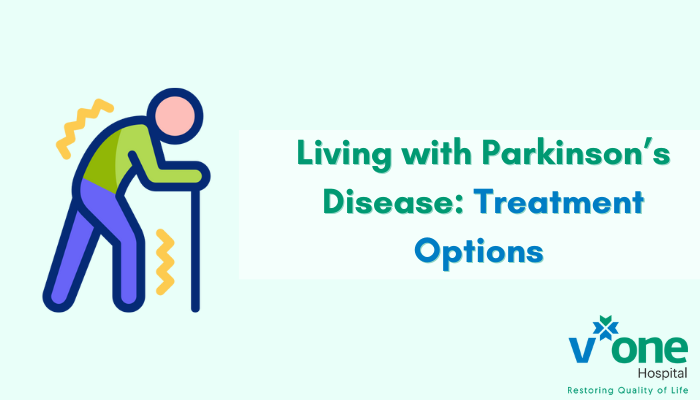Living with Parkinson’s Disease: Treatment Options and Support Strategies
Parkinson’s disease is a progressive neurological condition that affects movement, muscle control, and balance. It’s caused by the loss of dopamine-producing neurons in a part of the brain called the substantia nigra. Dopamine is a chemical messenger that plays a crucial role in sending signals to control movement. When its levels drop, a person may begin to experience tremors, stiffness, and slowed movements.
While Parkinson’s disease doesn’t have a cure yet, the good news is that it can be managed effectively. With the right treatment options and support strategies, people living with Parkinson’s can continue to lead active and fulfilling lives.
In this blog, we’ll explore the symptoms, treatment options, and how support systems can play a critical role in helping patients and families cope with the condition.
Understanding Parkinson’s Disease: Early Symptoms
Parkinson’s disease often develops gradually. Early symptoms can be mild and may go unnoticed at first. However, recognizing these signs can lead to early diagnosis and better disease management.
Common early symptoms include:
- Tremors: Usually starting in the hands or fingers when at rest.
- Bradykinesia: Slowness of movement, making everyday tasks take longer.
- Muscle stiffness: Leading to discomfort and limiting range of motion.
- Impaired posture and balance: Resulting in falls or stooping.
- Changes in speech or writing: Voice may become soft, or handwriting may shrink (micrographia).
Over time, symptoms may progress and affect other functions such as mood, sleep, and memory.
Treatment Options for Parkinson’s Disease
There’s no single treatment that fits all Parkinson’s patients. The management approach depends on the severity of symptoms, age, overall health, and lifestyle.
Here are the most commonly used treatments:
1. Medications
Medications are the first line of treatment for Parkinson’s disease. They help improve symptoms by increasing dopamine levels or mimicking its effects.
- Levodopa: The most effective drug, often combined with carbidopa to prevent nausea.
- Dopamine agonists: Mimic dopamine in the brain.
- MAO-B inhibitors: Help prevent dopamine breakdown.
- COMT inhibitors: Often used with levodopa to prolong its effects.
- Amantadine: May be used to control involuntary movements (dyskinesia).
A neurologist closely monitors medication schedules to balance symptom control with side effects.
2. Physical Therapy and Exercise
Regular exercise is one of the most powerful tools to slow the progression of Parkinson’s. It improves mobility, balance, and flexibility.
Common therapies include:
- Physiotherapy: For improving strength and movement.
- Occupational therapy: Helps patients manage daily activities.
- Speech therapy: For voice clarity and swallowing issues.
3. Surgical Treatment: Deep Brain Stimulation (DBS)
DBS is considered for patients who don’t respond well to medication or experience severe side effects. In this procedure, electrodes are implanted in specific brain regions and connected to a device that sends electrical impulses to help regulate movement.
It doesn’t cure Parkinson’s but can significantly reduce symptoms like tremors, stiffness, and rigidity.
4. Lifestyle Adjustments and Diet
- A healthy diet can help with medication absorption and ease digestive issues.
- Staying hydrated is important to manage blood pressure and bowel health.
- Routine sleep hygiene can improve quality of life as sleep disorders are common.
Simple adjustments, such as installing grab bars in bathrooms or using weighted utensils, can also support day-to-day living.
Support Strategies: Living Beyond the Diagnosis
Managing Parkinson’s is not just about medical treatments; emotional and social support are just as important.
1. Emotional Support
Living with Parkinson’s can be mentally taxing. Depression and anxiety are common but treatable.
- Counseling or therapy can help manage mental health.
- Support groups provide a sense of belonging and shared experience.
- Mindfulness techniques, such as meditation and breathing exercises, can ease stress.
2. Family and Caregiver Involvement
A strong support system makes a world of difference. Caregivers play a vital role in medication management, physical assistance, and emotional encouragement.
Encourage open communication, involve them in doctor visits, and educate them about the disease’s progression.
3. Regular Follow-ups with a Neurologist
Parkinson’s requires ongoing monitoring. Adjustments to medications, therapies, and overall care must be made based on how symptoms evolve.
If you’re searching for personalized, long-term neurological care, consulting the best neurologist in Indore can help you or your loved one receive expert treatment plans tailored to individual needs. A skilled neurologist not only provides accurate diagnosis and advanced treatment but also guides patients and families throughout their journey with Parkinson’s.
The Role of V One Hospital in Parkinson’s Care
V One Hospital, Indore, offers comprehensive neurological care under the guidance of experienced neurologists like Dr. Partisha Narayan Bhargava. With advanced diagnostic facilities, individualized treatment plans, and a multi-disciplinary care team, the hospital ensures that every Parkinson’s patient receives the best possible support—both physically and emotionally.
Final Thoughts
Parkinson’s disease can be challenging, but it’s not the end of the road. With timely diagnosis, a combination of treatments, and a strong support system, people can live well with Parkinson’s for many years.
Always consult a neurologist if you or a loved one shows early signs of Parkinson’s. With access to the best neurologist in Indore, comprehensive care and improved quality of life are well within reach.
Let Parkinson’s be a journey of strength and resilience—not fear. Take the first step toward better health today.

